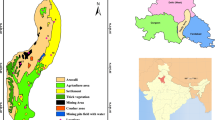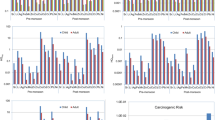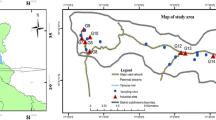Abstract
Haridwar once regarded as the holiest city of India has fast assumed the garb of an industrial destination after the establishment of the integrated industrial estate (IIE) Haridwar in the year 2000. IIE Haridwar is flanked by the Rajaji National Park and rural/agricultural areas in addition to urban residential, commercial and other industrial areas. Five heavy metals Cobalt (Co), Chromium (Cr), Iron (Fe), Nickel (Ni) and Zinc (Zn) were monitored monthly at 18 groundwater locations for a year in and around IIE Haridwar. Co was detected in 94 %, Fe in 99 % and Cr in 98 % samples; and Ni in 90 % and Zn in 99 % of the 216 samples. Co, Cr, Fe and Ni were found to exceed standard guideline limits in 196/216, 199/216, 71/216 and 147/216 samples, respectively. Two-way ANOVA showed main effects of season on concentrations of Fe and Zn. Significant correlations were identified between metal pairs Co–Cr and Fe–Zn. PCA identified two principal components, the anthropogenic pollution factor with loadings on Co and Cr and geogenic factor with loadings on Zn and Fe. HCA supported the findings of PCA and formed three clusters. Health risk assessment showed non-carcinogenic risk at all 17/18 locations due to Cr indicating adverse impact of industrial activity on human health.




Similar content being viewed by others
References
Akinmosin A, Osinowo OO, Oladunjoye MA (2009) Radiogenic components of the Nigeria Tars and Deposits. Earth Sci Res J 13(1):64–73
Alshikh A (2011) Analysis of heavy metals and organic pollutants of ground water samples of South Saudi. Life Sci J 8(4):438–441
ATSDR (2004) Toxicological profile for Cobalt. U.S. Department of Health and Human Services Public Health Service Agency for Toxic Substances and Disease Registry
ATSDR (2005) Toxicological review for Zinc. U.S. Department of Health and Human Services Public Health Service Agency for Toxic Substances and Disease Registry, June 2005
Barałkiewicz D, Siepak J (1999) Chromium, nickel and cobalt in environmental samples and existing legal norms. Pol J Environ Stud 8(4):201–208
Bharti PK, Pawan KP, Singh V (2013) Impact of industrial effluents on ground water and soil quality in the vicinity of industrial area of Panipat city, India. J Appl Nat Sci 5(1):132–136
Bielicka A, Bojanowska I, Wiśniewski A (2005) Two faces of chromium—pollutant and bioelement. Pol J Environ Stud 14(1):5–10
BIS 10500 (2012) Drinking water-specification (second revision), Gr 6. Bureau of Indian Standards, New Delhi
CGWB (2009) Groundwater brochure of Haridwar District. Central Ground Water Board Government of India Ministry of Water Resources, Uttaranchal
Chai LY, Wang ZY, Wang YY et al (2010) Ingestion risks of metals in groundwater based on TIN model and dose-response assessment—a case study in the Xiangjiang watershed, central-south China. Sci Total Environ 408:3118–3124
Dermentzis K, Christoforidis A, Valsamidou E (2011) Removal of nickel, copper, zinc and chromium from synthetic and industrial wastewater by electrocoagulation. Int J Environ Sci 1(5):2011
Elinge CM, Itodo AU, Peni IJ, Birnin-Yauri UA, Mbongo AN (2011) Assessment of heavy metals concentrations in bore-hole waters in Aliero community of Kebbi State. Adv Appl Sci Res 2(4):279–282
Etim EU, Onianwa PC (2013) Impact of effluent of an industrial estate on Oruku River in Southwestern Nigeria. World Appl Sci J 21(7):1075–1083
Felipe-Sotelo M, Andrade JM, Carlosena A, Tauler R (2007) Temporal characterisation of river waters in urban and semi-urban areas using physico-chemical parameters and chemometric methods. Anal Chim Acta 583:128–137
Gaur S, Joshi MC, Saxena SK, Dutt HK (2011) Analytical study of water safety parameters in ground water samples of Uttarakhand in India. Journal of Applied Pharmaceutical Science 01(09):166–169
Han YM, Du Cao PX, Posmentier JJ (2006) Multivariate analysis of heavy metal contamination in urban dusts of Xi’an, Central China. Sci Total Environ 355:176–186
Howard H (2002) Human health and heavy metals exposure. In: McCally M (ed) Life support: the environment and human health. MIT Press, Cambridge
Hu H (2002) Human health and heavy metals exposure. Chapter 4. In: McCally M (ed) Life support: the environment and human health. MIT Press, Cambridge
IARC (1990) Nickel and nickel compounds. In: Chromium, nickel and welding. IARC monographs on the evaluation of carcinogenic risks to humans, vol. 49. International Agency for Research on Cancer, Lyon, pp 257–445
Kannel PR, Lee S, Lee YS (2008) Assessment of spatial–temporal patterns of surface and ground water qualities and factors influencing management strategy of groundwater system in an urban river corridor of Nepal. J Environ Manage 86:595–604
Kapil DM, Mamta K, Sharma DK (2009) Hydrochemical analysis of drinking water quality of Alwar District Rajasthan. Nat Sci 7(2):30–39
Khan S, Shah IA, Muhammad S, Malik RN (2014) Arsenic and heavy metal concentrations in drinking water in Pakistan and risk assessment; a case study. Hum Ecol Risk Assess. doi:10.1080/10807039.2014.950925
Konstantinos D, Achilleas C, Evgenia V (2011) Removal of nickel, copper, zinc and chromium from synthetic and industrial wastewater by electrocoagulation. Int J Environ Sci 1(5):697–710
Kowalkowski T, Zbytniewski R, Szpejna J, Buszewski B (2006) Application of chemometrics in river water classification. Water Res 40:744–752
Li J, Li FD, Liu Q et al (2014) Impacts of Yellow River irrigation practice on trace metals in surface water: a case study of the Henan-Liaocheng Irrigation Area, China. Hum Ecol Risk Assess 20:1042–1057
Musa OK, Shaibu MM, Kudamnya EA (2013) Heavy metal concentration in groundwater around Obajana and its environs, Kogi State, North Central Nigeria. Am Int J Contemp Res 3(8):170–177
Nair GA, Mohamed AI, Premkumar K (2005) Physico chemical parameters and correlation coefficients of ground waters of North-East Libya. Pollut Res 24(1):1–6
Quazi MA, Khattak AA, Khan MSA, Chaudhry MN, Mahmood K, Akhter B, Iqbal N, Ilyas S, Ali UA (2014) Spatial distribution of heavy metals in ground water of Sheikhupura district Punjab, Pakistan. J Agric Res 52(1):99–110
Ramola B, Singh A (2013) Heavy metal concentrations in pharmaceutical effluents of industrial area of Dehradun (Uttarakhand). India. Int J Environ Sci Res 2(2):140–145
Ravichandran K, Jayaprakash M (2011) Seasonal variation on physico-chemical parameters and trace metals in groundwater of an industrial area of north Chennai, India. Indian J Sci Technol 4(6):646–649. ISSN: 0974–6846
Reisenhofer E, Adami G, Barbieri P (1998) Using chemical and physical parameters to define the quality of karstic freshwaters (Timavo River, North-eastern Italy): a chemometric approach. Water Res 32:1193–1203
Sekhar KC, Chary NS, Kamala CT, Vairamani M, Anjaneyulu Y, Balaram V, Sorlie JE (2006) Environmental risk assessment studies of heavy metal contamination in the industrial Area of Kattedan, India—a case study. Hum Ecol Risk Assess 12(2):408–422. doi:10.1080/10807030500531513
Sharma V, Verma SM, Sakhuja N, Arora D (2011) Impact of heavy metals (Chromium and Nickel) on the health of residents of Jagadhri city due to intake of contaminated underground water. Arch Appl Sci Res 3(5):207–212
Shivasharanappa SP, Huggi MS (2012) Study on the physico-chemical characteristics of ground water of Bidar city and its industrial area. Int J Appl Biol Pharm Technol 3(1):359–367
Singhal DC, Israil M, Sharma VK, Kumar B (2010) Evaluation of groundwater resource and estimation of its potential in Pathri Rao watershed, district Haridwar (Uttarakhand). Curr Sci 98(2):162–170
Sirajudeen J, Manikandan SA, Naveen J (2012) Seasonal variation of heavy metal contamination of ground water in and around Uyyakondan channel Tiruchirappalli district, Tamil Nadu. Der Chemica Sinica 3(5):1113–1119
Thomas DR, Sunil B, Latha C (2011) Physico-chemical analysis of well water at Eloor industrial area-seasonal study. Curr World Environ 6(2):259–264
Ullah R, Malik RN, Qadir A (2009) Assessment of groundwater contamination in an industrial city, Sialkot, Pakistan. Afr J Environ Sci Technol 3(12):429–446
USEPA (1989) Risk assessment guidance for superfund volume I human health evaluation manual. United States Environmental Protection Agency EPA/540/l-89/002, December 1989
USEPA (1998) Toxicological review of Hexavalent chromium. In: Support of summary information on the integrated risk information system (IRIS). United States Environmental Protection Agency August 1998. CAS No. 18540-29-9
USEPA (2004) Risk assessment guidance for superfund volume I; Human health evaluation manual (part E, supplemental guidance for dermal risk assessment). United States Environmental Protection Agency. EPA/540/R/99/005. OSWER 9285.7-02EP. PB99-963312
USEPA (2005) Toxicological review of zinc and compounds. In: Support of summary information on the integrated risk information system (IRIS). U.S. Environmental Protection Agency Washington D.C. EPA/635/R-05/002. (CAS No. 7440-66-6)
USEPA (2009) Contaminant information sheets for the final CCL 3 Chemicals. Office of Water (4607M). United States Environmental Protection Agency. EPA 815-R-09-012
USEPA (2011) 2011 edition of the drinking water standards and health advisories. United States Environmental Protection Agency. EPA 820-R-11-002
USEPA (2014) Human health evaluation manual, supplemental guidance: update of standard default exposure factors. United States Environmental Protection Agency OSWER Directive 9200.1-120
Virha R, Biswas AK, Kakaria VK, Qureshi TA, Borana K, Malik N (2010) Seasonal variation in physicochemical parameters and heavy metals in water of Upper Lake of Bhopal. Bull Environ Contam Toxicol. doi:10.1007/s00128-010-0172-0
WHO (2003a) Chromium in drinking water, background document for development of WHO guidelines for drinking-water quality. World Health Organisation. WHO/SDE/WSH/03.04/04
WHO (2003b) Iron in drinking-water. Background document for development of WHO guidelines for drinking-water quality. World Health Organization. WHO/SDE/WSH/03.04/08
WHO (2003c) Zinc in drinking water, background document for development of WHO guidelines for drinking-water quality. World Health Organization. WHO/SDE/WSH/07.08/55
WHO (2007) Nickel in drinking water. Background document for development of WHO guidelines for drinking-water quality. World Health Organization.WHO/SDE/WSH/07.08/55
WHO (2011) Guidelines for drinking-water quality, 4th edn. World Health Organization. ISBN 978 92 4 154815 1
Zamani AA, Mohammad RYMR, Parizanganeh A (2012) Multivariate statistical assessment of heavy metal pollution sources of groundwater around a lead and zinc plant. Iran J Environ Health Sci Eng 9:29. http://www.ijehse.com/content/9/1/29
Zhang J, Li X (1987) Chromium pollution of soil and water in Jinzhou. J Chin Prev Med 21:262–264
Acknowledgments
This research work of Author Dipali Bhaskar Kulkarni was supported by the University Grants Commission (UGC) under grant No. F.7-70/2007(BSR)/UGC-BSR Research Fellowships in Sciences, Bio-Sciences, Agricultural Sciences, Medical Sciences and Engineering Sciences. The authors wish to thank the Department of Environmental Sciences, Pantnagar Agricultural University, Pantnagar, Uttarakhand, India for providing instrumentation and facilities for the analysis of heavy metals.
Author information
Authors and Affiliations
Corresponding author
Ethics declarations
Conflict of interest
The authors have no conflict of interest arising from the direct application of this research work.
Rights and permissions
About this article
Cite this article
Bhutiani, R., Kulkarni, D.B., Khanna, D.R. et al. Water Quality, Pollution Source Apportionment and Health Risk Assessment of Heavy Metals in Groundwater of an Industrial Area in North India. Expo Health 8, 3–18 (2016). https://doi.org/10.1007/s12403-015-0178-2
Received:
Revised:
Accepted:
Published:
Issue Date:
DOI: https://doi.org/10.1007/s12403-015-0178-2




